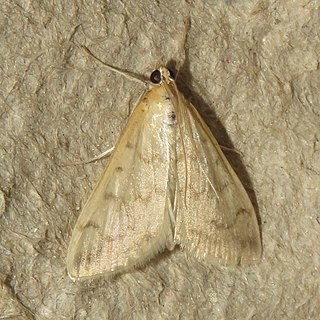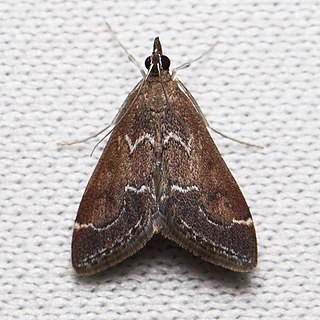
Loxostege is a genus of moths of the family Crambidae.

Hellula rogatalis, the cabbage webworm, is a moth of the family Crambidae described by George Duryea Hulst in 1886. It is found from the southern United States north in the east to Maryland, New York and Ontario. It is also found in Mexico, where it has been recorded from Distrito Federal.
Abegesta reluctalis is a moth in the family Crambidae. It was described by George Duryea Hulst in 1886. It is found in North America, where it has been recorded from Arizona, California, Maryland and New Mexico.

Hahncappsia pergilvalis is a moth in the family Crambidae. It was described by George Duryea Hulst in 1886. It is found in North America, where it has been recorded from Ontario and the north-eastern and south-western United States. It is also present in Mexico, where it has been recorded from the Federal District, Puebla and Jalisco.

Loxostege allectalis is a moth in the family Crambidae. It was described by Augustus Radcliffe Grote in 1877. It is found in the United States, where it has been recorded from southern California to Texas. To the south, the range extends into Mexico and Central America.
Loxostege anartalis is a moth in the family Crambidae. It was described by Augustus Radcliffe Grote in 1878. It is found in North America, where it has been recorded from coast to coast in Canada. In the west, the range extends south to California.

Loxostege lepidalis is a moth in the family Crambidae. It was described by George Duryea Hulst in 1886. It is found in North America, where it has been recorded from Alberta and eastern Washington to California and New Mexico.
Loxostege kearfottalis is a moth in the family Crambidae. It was described by E. V. Walter in 1928. It is found in North America, where it has been recorded from California to western Texas and in Colorado.
Loxostege mojavealis is a moth in the family Crambidae. It was described by Hahn William Capps in 1967. It is found in North America, where it has been recorded from the Mojave Desert in Arizona and California.
Loxostege oberthuralis is a moth in the family Crambidae. It was described by Charles H. Fernald in 1894. It is found in North America, where it has been recorded from southern California, southern Arizona and southern Nevada.
Loxostege quaestoralis is a moth in the family Crambidae. It was described by William Barnes and James Halliday McDunnough in 1914. It is found in North America, where it has been recorded from California to New Mexico.
Loxostege thrallophilalis is a moth in the family Crambidae. It was described by George Duryea Hulst in 1886. It is found in North America, where it has been recorded from southern British Columbia to northern California, as well as from Montana.

Pyrausta napaealis is a moth in the family Crambidae. It was described by George Duryea Hulst in 1886. It is found in the United States, where it has been recorded from Washington to California and west to Arizona, Nevada, New Mexico and Texas. It is also found in northern Mexico.

Pyrausta nexalis, the fulvous-edged pyrausta moth, is a moth in the family Crambidae. It was described by George Duryea Hulst in 1886. It is found in North America, where it has been recorded from Washington, Montana, Arizona, California, New Mexico, Oklahoma, Texas and Utah.
Saucrobotys fumoferalis, the dusky saucrobotys moth, is a moth in the family Crambidae. It was described by George Duryea Hulst in 1886. It is found in North America, where it has been recorded from Nova Scotia west to British Columbia, north to Yukon, and south to Pennsylvania, Illinois and California. The habitat consists of boreal forests, mixed forests and woodlots.
Sitochroa aureolalis is a moth in the family Crambidae. It was described by George Duryea Hulst in 1886. It is found in the United States, where it has been recorded from southern California to Arizona and Texas. It is also found in northern Mexico.

Chloropteryx tepperaria, the angle-winged emerald moth, is a moth of the family Geometridae. The species was first described by George Duryea Hulst in 1886 and it is found in the southeastern United States.
Noctueliopsis bububattalis is a moth in the family Crambidae. It was described by George Duryea Hulst in 1886. It is found in North America, where it has been recorded from Arizona, California, Colorado, New Mexico, Texas and Utah.
Samea baccatalis is a moth in the family Crambidae. It is found in North America, where it has been recorded from Alabama, Arizona, Florida, Georgia, Louisiana, Mississippi, Oklahoma, South Carolina and Texas. It is also found in Central America, where it has been recorded from Costa Rica.
Udea octosignalis is a moth in the family Crambidae. It was described by George Duryea Hulst in 1886. It is found in North America, where it has been recorded from California and Texas.







